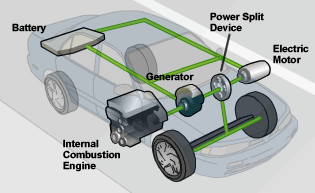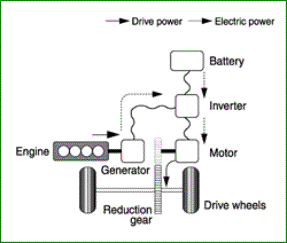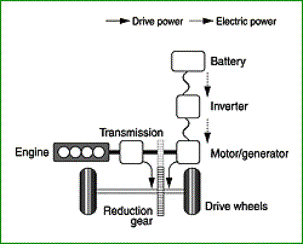| Previous Module - Next
Module
Hybrid Electric Vehicles
|
A.Boyali (*) -
C.Pianese (**) - M.Sorrentino (**)
|
|
(*) Istanbul Technical
University - (**) DIMEC, Università di Salerno |
Summary
This section explains the definition
the terms “hybrid” and hybrid electric vehicles, why we need this kind of technology,
a brief history, current hybrid electric vehicle applications and their architecture.
Why Hybrid Electric Vehicles
Before we begin, we should
know what the term “hybrid” means. The term hybrid can be stated concisely
as the use of two or more power sources to operate any kind of system.
In relation to the terminology “hybrid electric vehicles”, it means to
propel the vehicle using two or more power sources such as an electric
motor, an internal combustion engine or solar energy.
The world’s population is increasing day by day. This will give rise to an increase in the mobility requirements of our population. In contrast, natural resources are moving to the verge of a dangerous balance point due to increased air pollution and its detrimental effects on nature. This is because current vehicles are mostly propelled by internal combustion engines that use fossil fuels. The contribution of road vehicles to air pollution and global warming due to the their carbon monoxide emission is very high. For this reason, scientists and researchers are trying to find new energy sources to alleviate the exhaust emissions emitted by road vehicles.

Figure 1. Global warming and effects
(Source: www.augustachronicle.com )
There are clean alternative energy sources such as hydrogen
and electricity. But the infrastructure is not mature enough and the travel
range with these sources cannot compete with the range available by fossil
fuels. An intermediate solution is thus required. The remedy is hybrid
vehicles.
Brief History of Hybrid Electric Vehicles
Although the history of hybrid
electric vehicles dates back to the 17th century, the first mass
produced hybrid electric vehicle, the Toyota Prius, was introduced in 1997 to
the Japanese market. After this step of Toyota, Honda introduced the Insight
model in 2000.
How a Hybrid Electric Vehicle Works
Hybrid electric vehicles use two
propulsion units. These are an electric motor and an internal combustion engine.
During vehicle motion, these two hybrid electric vehicle power sources are stepped
in from time to time to achieve low fuel consumption and low greenhouse gas
emissions. The main components of hybrid electric vehicles are the electric motor
also used as a generator, the batteries and the coupling devices (see Fig. 2).

Figure 2. Components
of Hybrid Electric Vehicles
(Source: http://www.fueleconomy.gov/feg/hybridtech.shtml)
The electric motor supplies its
energy from the batteries whereas the internal combustion engine uses the fuel
tank for this purpose. Electric motor and internal combustion engines are connected
to each other via mechanical devices. Battery energy is replenished in two ways
during travel of hybrid electric vehicles. One of them is regenerative braking.
The latter one is operating the electric motor as a generator to generate electricity
during normal operation.
There are mainly two different
architectures of a hybrid electric vehicle which are the series and the parallel
architectures.
Series Hybrid Electric Vehicles
In the series hybrid configuration,
the internal combustion engine is only used to charge the batteries. There is
no mechanical connection between the electric motor and the internal combustion
engine (Fig 3.). When the charge of the battery reaches it’s allowed minimum
level, the internal combustion engine starts to charge the battery. When the
battery is fully charged, the internal combustion engine shuts off. In this
configuration, the internal combustion engine runs at its most efficient region.
The main disadvantage of this configuration is that, there are energy losses
during the conversion of energy from fuel energy to electricity and from electricity
to mechanical energy.

Figure 3. Series Hybrid
Electric Vehicle Configuration
(Source: http://www.toyota.co.jp/en/tech/environment/ths2/what.html)
Parallel Hybrid Electric Vehicles
In the parallel configuration,
both the electric motor and the internal combustion engine drive the wheels
according to preferred efficiency paths. The electric motor and the internal
combustion engine are coupled in a parallel manner. If the charge of battery
is low, the electric motor acts as a generator to replenish the battery.

Figure 4. Parallel
Hybrid Electric Vehicle Configuration
(Source: http://www.toyota.co.jp/en/tech/environment/ths2/what.html)
Energetic benefits of vehicle hybridization
The positive impact of vehicle
hybridization on fuel economy is twofold. Fist of all, the presence of
battery allows operating the engine mostly at its best efficiency. For
the series structure, this is achieved by designing the powertrain in
such a way that the engine works at one operating condition, corresponding
to its max conversion efficiency. Therefore, the peaks in power demand
are met by the batteries. For the parallel lay-out, the engine is better
operated with respect to conventional vehicle, mainly because of two reasons:
downsizing and opportunity of turning off the engine during urban driving,
where ICE fuel economy is usually very low. In this case, the depletion
in battery state of charge is compensated by turning on the engine in
highway routes and demanding more power to recharge batteries.
The second important benefit relates to regenerative braking. Through
such process, the negative torque required to slow down the vehicle is
provided by the electric motor/generator, in both series and parallel
structure. Therefore, the vehicle kinetic energy, which is generally lost
in heat in conventional vehicles, can be recovered and restored in the
battery pack. Regenerative braking significantly contributes to decreasing
fuel economy. As an example, in urban driving (i.e. ECE driving schedule)
the fuel savings obtained via regenerative braking reaches up to 15/20%
with respect to same power-to-weight-ratio conventional cars.
Top - Previous
Module - Next Module
|






